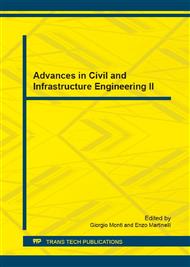p.463
p.469
p.479
p.485
p.492
p.505
p.513
p.521
p.529
Multi-Performance Innovative Infill Panels
Abstract:
Infill panels and partitions are widely used non-structural elements in reinforced concrete buildings, characterized by a significant seismic vulnerability as testified by disastrous collapses observed during recent earthquakes, for both in-plane and out-of-plane actions. The most advanced building codes foresee mandatory verifications of these elements, both when designing a new building and when assessing the seismic adequacy of an existing one. Moreover, recent evaluations have shown that, after low-intensity earthquakes, damage of non-structural parts strongly influences repair costs for typical multi-storey buildings. In this paper, an innovative concept for infill panels and partitions is presented, in which (either concrete or clay) blocks are connected, rather than with the usual mortar layers, by means of recycled-plastic joints. A comparison is also carried out with respect to conventional infill typologies, by evaluating their performance in terms of energy efficiency and acoustic. A brief description of seismic performances of innovative infill panels are shown at the end of work.
Info:
Periodical:
Pages:
492-504
Citation:
Online since:
July 2016
Authors:
Price:
Сopyright:
© 2016 Trans Tech Publications Ltd. All Rights Reserved
Share:
Citation:


